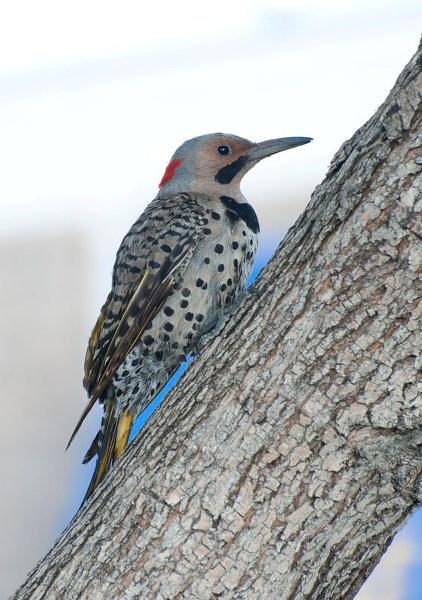Want a new look? Start with a black and white tuxedo. Now, turn the white undershirt black and make the suit brownish with black polka-dots. Make the inner lining as bright and yellow as the sun, and grow a luxurious moustache. Oh, and start eating ants.
Congratulations. You now look either completely ridiculous or like a northern flicker. Possibly both.
The northern flicker is a medium-sized woodpecker known for its eccentric taste in clothes. It’s mostly brown with black spots, but has a black bib, a white rump, a red patch on the back of its head, and a black moustache (if male).
Most northern flickers around Edmonton have bright yellow feathers under their wings and tails, making them yellow-shafted flickers, says Jocelyn Hudon, who has studied the birds extensively as curator of ornithology at the Royal Alberta Museum.
Much more rare here is the red-shafted variant, which is red instead of yellow under its tail and wings, has a red moustache and lacks the red patch behind its head.
Red and yellow-shafted flickers look so different that they were once thought to be separate species, but researchers now know that they are not, and hybridize easily, Hudon says. You can spot a hybrid by its mixed colour scheme – orange under-wings, for example, or a half red, half black moustache.
Red-shafted flickers frequent Calgary and the West Coast, while yellow ones prefer Edmonton and the east.
Hudon says researchers aren’t sure why there’s such a strong geographic split between North America’s red and yellow northern flickers, but suspect the two were separated during the last ice age. The darker colours of the red-shafted flicker could be an advantage in B.C.’s thicker, darker forests, he continues – many other birds also come in darker versions out west as well.
As for the flicker’s strange fashion sense, Hudon notes that the polka dots could camouflage the northern flicker from other predators. The coloured patches could also break up the shape of its profile, making it harder to identify.
Northern flickers are usually seen hopping on the ground, eating ants with their long, barbed tongues. Unlike the pileated woodpecker, they prefer ground-crawling ants to ones hidden in old trees. When surprised, they’ll usually hop onto a branch instead of clinging to the side of a tree like most woodpeckers.
You won’t find any other woodpecker around that does those things, says Jim Lange, employee at the Wildbird General Store in Edmonton.
“They’re the one woodpecker that people don’t recognize (as woodpeckers) because they see them on the ground.”
In flight, you’ll see these birds flash their brilliant golden under-wings at you with every stroke.
Hudon says this colour may be there for mating purposes, as the birds will spread their colourful tails when wooing a mate.
Competing males may also face off and wave their long beaks at each other as a lady looks on, notes the Cornell Lab of Ornithology – a practice known as fencing. Use your imagination, and you can hear the sound of invisible rapiers clashing in the air as they do so.
Northern flickers have a “wik-wik-wik” territorial call that closely resembles that of a pileated woodpecker, Hudon notes. Like other woodpeckers, they will also drum on objects to stake out turf. Distinct to them is the loud “KYEER!” call, which is what they use to keep tabs on each other’s location.
The North American Breeding Bird Survey suggests that there was a 46 per cent drop in northern flicker numbers between 1966 and 2010, reports the Cornell Lab. Despite this, they are not considered to be at risk of extinction.
No one’s sure what’s causing this decline, but it could be the result of habitat loss due to logging, Hudon says. Humans can help these birds by leaving more dead and dying trees around in tree stands for them to nest in.
Northern flickers tend to disappear from the countryside around here during the winter due to a lack of food, notes Lange. A few do stick around in the city, though – a record 17 were spotted in the most recent St. Albert Christmas bird count, for example.
Put out suet and nuts if you want to attract them, Lange suggests. A rotting aspen poplar can also make an attractive home for a northern flicker.
But if you want fashion advice, you might want to look elsewhere.
Northern flicker
Name: <br />Colaptes auratus.<br /><br />Appearance: <br />Big brown woodpecker covered with black polka-dots. Has a long, slightly curved beak, a black patch on its chest, a red patch behind its head, and (around here) yellow feathers under its wings and tail. Some variants have red feathers instead of yellow ones. <br /><br />Commonly seen:<br />Hopping along the ground, eating ants, or perched on a low branch.<br /><br />Occasionally confused with: <br />The yellow-bellied sapsucker, which has a red cap and a black and white striped face. The red-bellied woodpecker and gilded flicker look like the northern flicker, but aren’t found in this region.<br /><br />Fun fact: <br />In 1995, two northern flickers delayed the launch of the space shuttle Discovery by a month after they tried to dig a nest hole in its giant external fuel tank. The birds apparently mistook the soft insulation on the tank for rotted wood and pecked about 205 holes in it, necessitating extensive repairs. NASA later deployed deterrents to protect their rockets from these feathered saboteurs.
Wild St. Albert
Like wildlife? So do we! Every second Wednesday the Gazette profiles a reasonably common wild creature in the St. Albert region. Birds, beasts, bugs, fish … so long as it's alive and kicking, we’ll feature it. <br /><br />Got a creature you’d like to see profiled? Send your suggestions to [email protected].




